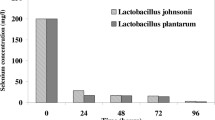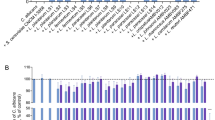Abstract
There is great interest in the search for new alternatives to antimicrobial drugs, and the use of prebiotics and probiotics is a promising approach to this problem. This study aimed to assess the effect of inulin-type fructans, used in synbiotic combinations with Lactobacillus paracasei or Lactobacillus plantarum, on the production of short-chain fatty acids and antimicrobial activity against Candida albicans. The inhibition assay using the L. paracasei and L. plantarum supernatants resulting from the metabolization of inulin-type fructans displayed growth inhibition and antibiofilm formation against C. albicans. Inhibition occurred at concentrations of 12.5, 25, and 50% of the L. paracasei supernatant and at a concentration of 50% of the L. plantarum supernatant. The analysis of short-chain fatty acids by gas chromatography showed that lactic acid was the dominating produced metabolite. However, acetic, propionic, and butyric acids were also detected in supernatants from both probiotics. Therefore, the synbiotic formulation of L. paracasei or L. plantarum in the presence of inulin-type fructans constitutes with anticandidal effect is a possible option to produce antifungal drugs or antimicrobial compounds.



Similar content being viewed by others
Data Availability
The datasets generated during and/or analysed during the current study are available from the corresponding author on reasonable request.
References
Frassinetti S, Gabriele M, Moccia E et al (2020) Antimicrobial and antibiofilm activity of Cannabis sativa L. seeds extract against Staphylococcus aureus and growth effects on probiotic Lactobacillus spp. LWT-Food Sci Technol 124:109149. https://doi.org/10.1016/j.lwt.2020.109149
Senés-Guerrero C, Gradilla-Hernández MS, García-Gamboa R, García-Cayuela T (2020) Dietary fiber and gut microbiota. In: Science and Technology of Fibers in food systems. Springer International Publishing, pp 277–298. https://doi.org/10.1007/978-3-030-38654-2_12
Márquez-Aguirre AL, Camacho-Ruíz RM, Gutiérrez-Mercado YK et al (2016) Fructans from Agave tequilana with a lower degree of polymerization prevent weight gain, hyperglycemia and liver steatosis in high-fat diet-induced obese mice. Plant Foods Hum Nutr 71:416–421. https://doi.org/10.1007/s11130-016-0578-x
García-Gamboa R, Basurto RIO, Santoyo MC et al (2018) In vitro evaluation of prebiotic activity, pathogen inhibition and enzymatic metabolism of intestinal bacteria in the presence of fructans extracted from agave: a comparison based on polymerization degree. LWT-Food Sci Technol 92:380–387. https://doi.org/10.1016/j.lwt.2018.02.051
García-Gamboa R, Gradilla-Hernández MS, Ortiz-Basurto RI et al (2020) Assessment of intermediate and long chains agave fructan fermentation on the growth of intestinal bacteria cultured in a gastrointestinal tract simulator. Rev Mex Ing Quim 19:827–838. https://doi.org/10.24275/rmiq/Bio842
Zhao C, Lv X, Fu J et al (2016) In vitro inhibitory activity of probiotic products against oral Candida species. J Appl Microbiol 121:254–262. https://doi.org/10.1111/jam.13138
Aarti C, Khusro A, Varghese R et al (2018) In vitro investigation on probiotic, anti-Candida, and antibiofilm properties of Lactobacillus pentosus strain LAP1. Arch Oral Biol 89:99–106. https://doi.org/10.1016/j.archoralbio.2018.02.014
Kim H, Kang S-S (2019) Antifungal activities against Candida albicans, of cell-free supernatants obtained from probiotic Pediococcus acidilactici HW01. Arch Oral Biol 99:113–119. https://doi.org/10.1016/j.archoralbio.2019.01.006
García-Gamboa R, Kirchmayr MR, Gradilla-Hernández MS et al (2021) The intestinal mycobiota and its relationship with overweight, obesity and nutritional aspects. J Hum Nutr Diet 34:645–655. https://doi.org/10.1111/jhn.12864
Williams DW, Jordan RPC, Wei X-Q et al (2013) Interactions of Candida albicans with host epithelial surfaces. J Oral Microbiol 5:22434. https://doi.org/10.3402/jom.v5i0.22434
Bhattacharya S, Sae-Tia S, Fries BC (2020) Candidiasis and mechanisms of antifungal resistance. Antibiotics 9:312. https://doi.org/10.3390/antibiotics9060312
Atriwal T, Azeem K, Husain FM et al (2021) Mechanistic understanding of Candida albicans biofilm formation and approaches for its inhibition. Front Microbiol 12:932. https://doi.org/10.3389/fmicb.2021.638609
Nami S, Aghebati-Maleki A, Morovati H, Aghebati-Maleki L (2019) Current antifungal drugs and immunotherapeutic approaches as promising strategies to treatment of fungal diseases. Biomed Pharmacother 110:857–868. https://doi.org/10.1016/j.biopha.2018.12.009
Popp C, Ramírez-Zavala B, Schwanfelder S et al (2019) Evolution of fluconazole-resistant Candida albicans strains by drug-induced mating competence and parasexual recombination. MBio 10:02740–02718. https://doi.org/10.1128/mBio.02740-18
Rossoni RD, de Barros PP, do Carmo Mendonça I et al (2020) The postbiotic activity of Lactobacillus paracasei 28.4 against Candida auris. Front Cell Infect Microbiol 10:397. https://doi.org/10.3389/fcimb.2020.00397
Valero-Cases E, Frutos MJ (2017) Effect of inulin on the viability of L. plantarum during storage and in vitro digestion and on composition parameters of vegetable fermented juices. Plant Foods Hum Nutr 72:161–167. https://doi.org/10.1007/s11130-017-0601-x
Siedler S, Balti R, Neves AR (2019) Bioprotective mechanisms of lactic acid bacteria against fungal spoilage of food. Curr Opin Biotechnol 56:138–146. https://doi.org/10.1016/j.copbio.2018.11.015
Roobab U, Batool Z, Manzoor MF et al (2020) Sources, formulations, advanced delivery and health benefits of probiotics. Curr Opin Food Sci 32:17–28. https://doi.org/10.1016/j.cofs.2020.01.003
Petrov K, Popova L, Petrova P (2017) High lactic acid and fructose production via Mn2+-mediated conversion of inulin by Lactobacillus paracasei. Appl Microbiol Biotechnol 101:4433–4445. https://doi.org/10.1007/s00253-017-8238-0
Okano K, Hama S, Kihara M et al (2017) Production of optically pure D-lactic acid from brown rice using metabolically engineered Lactobacillus plantarum. Appl Microbiol Biotechnol 101:1869–1875. https://doi.org/10.1007/s00253-016-7976-8
Parolin C, Marangoni A, Laghi L et al (2015) Isolation of vaginal lactobacilli and characterization of anti-Candida activity. PLoS One 10:e0131220. https://doi.org/10.1371/journal.pone.0131220
Asadpoor M, Ithakisiou G-N, Henricks PAJ et al (2021) Non-digestible oligosaccharides and short chain fatty acids as therapeutic targets against enterotoxin-producing bacteria and their toxins. Toxins 13:175. https://doi.org/10.3390/toxins13030175
Peng S, Song J, Zeng W et al (2021) A broad-spectrum novel bacteriocin produced by Lactobacillus plantarum SHY 21–2 from yak yogurt: purification, antimicrobial characteristics and antibacterial mechanism. LWT-Food Sci Technol 142:110955. https://doi.org/10.1016/j.lwt.2021.110955
de Barros PP, Scorzoni L, de Camargo RF et al (2018) Lactobacillus paracasei 28.4 reduces in vitro hyphae formation of Candida albicans and prevents the filamentation in an experimental model of Caenorhabditis elegans. Microb Pathog 117:80–87. https://doi.org/10.1016/j.micpath.2018.02.019
Salari S, Ghasemi Nejad Almani P (2020) Antifungal effects of Lactobacillus acidophilus and Lactobacillus plantarum against different oral Candida species isolated from HIV/AIDS patients: an in vitro study. J Oral Microbiol 12:1769386. https://doi.org/10.1016/j.micpath.2018.02.019
Kim S, Covington A, Pamer EG (2017) The intestinal microbiota: antibiotics, colonization resistance, and enteric pathogens. Immunol Rev 279:90–105. https://doi.org/10.1111/imr.12563
Cronin SJF, Nehme NT, Limmer S et al (2009) Genome-wide RNAi screen identifies genes involved in intestinal pathogenic bacterial infection. Science 325:340–343. https://doi.org/10.1126/science.1173164
Healey KR, Nagasaki Y, Zimmerman M et al (2017) The gastrointestinal tract is a major source of echinocandin drug resistance in a murine model of Candida glabrata colonization and systemic dissemination. Antimicrob Agents Chemother 61:e01412–e01417. https://doi.org/10.1128/AAC.01412-17
Sanders ME, Merenstein DJ, Reid G et al (2019) Probiotics and prebiotics in intestinal health and disease: from biology to the clinic. Nat Rev Gastroenterol Hepatol 16:605–616. https://doi.org/10.1038/s41575-019-0173-3
Nobile CJ, Johnson AD (2015) Candida albicans biofilms and human disease. Annu Rev Microbiol 69:71–92. https://doi.org/10.1146/annurev-micro-091014-104330
Ribeiro FC, Rossoni RD, de Barros PP et al (2020) Action mechanisms of probiotics on Candida spp. and candidiasis prevention: an update. J Appl Microbiol 129:175–185. https://doi.org/10.1111/jam.14511
Ceresa C, Tessarolo F, Caola I et al (2015) Inhibition of Candida albicans adhesion on medical-grade silicone by a Lactobacillus-derived biosurfactant. J Appl Microbiol 118:1116–1125. https://doi.org/10.1111/jam.1276
Higashi B, Mariano TB, de Abreu Filho BA et al (2020) Effects of fructans and probiotics on the inhibition of Klebsiella oxytoca and the production of short-chain fatty acids assessed by NMR spectroscopy. Carbohydr Polym 248:116832. https://doi.org/10.1016/j.carbpol.2020.116832
Guinan J, Wang S, Hazbun TR et al (2019) Antibiotic-induced decreases in the levels of microbial-derived short-chain fatty acids correlate with increased gastrointestinal colonization of Candida albicans. Sci Rep 9:1–11. https://doi.org/10.1038/s41598-019-45467-7
van Leeuwen PT, van der Peet JM, Bikker FJ et al (2016) Interspecies interactions between Clostridium difficile and Candida albicans. Msphere 1:e00187–e00116. https://doi.org/10.1128/mSphere.00187-16
Acknowledgments
The authors would like to thank the financial support granted by CONACYT (CVU number 662891).
Author information
Authors and Affiliations
Corresponding author
Ethics declarations
Conflict of Interest
The authors confirm that they have no conflict of interest.
Additional information
Publisher’s Note
Springer Nature remains neutral with regard to jurisdictional claims in published maps and institutional affiliations.
Rights and permissions
About this article
Cite this article
García-Gamboa, R., Domínguez-Simi, M.Á., Gradilla-Hernández, M.S. et al. Antimicrobial and Antibiofilm Effect of Inulin-Type Fructans, Used in Synbiotic Combination with Lactobacillus spp. Against Candida albicans. Plant Foods Hum Nutr 77, 212–219 (2022). https://doi.org/10.1007/s11130-022-00966-3
Accepted:
Published:
Issue Date:
DOI: https://doi.org/10.1007/s11130-022-00966-3




